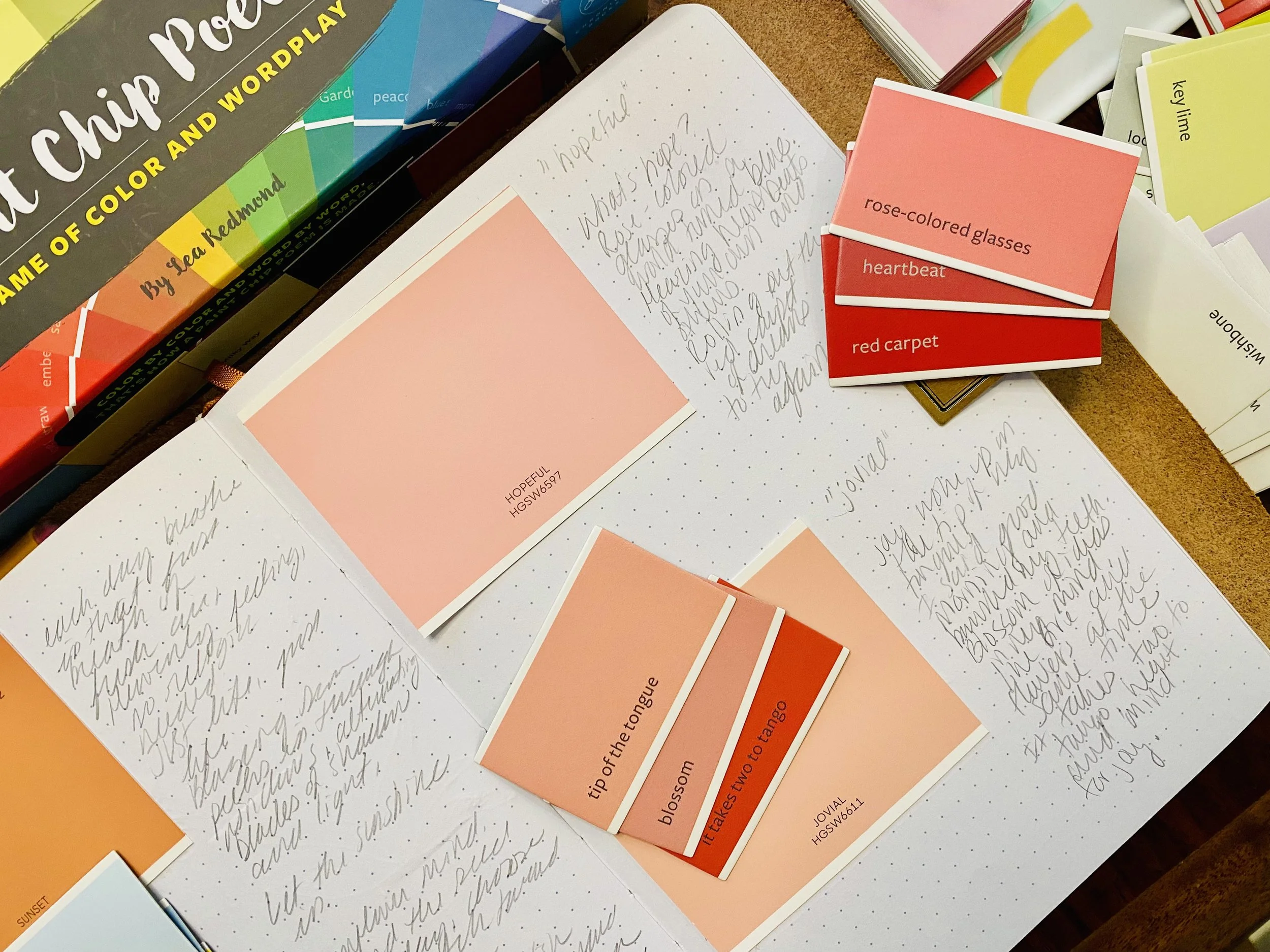Painting with Words: Using Paint Chip Poetry & Color Work in Your Outdoor Journal
Our daughter’s favorite part of a trip to Lowe’s is walking through the garden section to see the flowers and collecting a stack of “rainbows”—color paint sample cards. After one of these trips, I remembered that I had a writing prompt kit called Paint Chip Poetry. This little box includes a wide variety of colors, each paired with a word or phrase, along with prompts to spark ideas. There’s something magical about color—how a single shade can evoke a memory, tell a story, or capture the essence of a season. When we combine that sensory experience with the power of words, we open up an entirely new pathway to creativity.
One of my favorite tools for inspiring outdoor journaling is using paint chips taped into a notebook. Paint chip poetry and color-based activities offer an accessible, playful, and deeply reflective way to connect with nature, especially when paired with time spent outside. Whether you’re journaling in your backyard, at a park, or on a classroom nature walk, these activities add a vibrant lens to the experience.
This post outlines five color-inspired journaling activities to try with your students or in your own nature notebook. It also includes recommended picture books that serve as wonderful resources for kids of all ages, from upper elementary to high school.
My Notebook
Try to find the colors in an image from a walk outside. Use these words as brainstorming for your writing.
Grab paint chip cards from Lowes or any hardware store and tape them in your notebook. Use the title of the color as inspiration for when you need it.
Use the name of the paint chip card as inspiration. For “sunset” I tried to grab all the colors I could remember from a recent sunset on a family walk.
My Favorite Lines
“Joy woke up on the tip of my tongue”
“It takes two to tango, heart and mind, to welcome joy”
“Let the sunshine in”
“Sunflower mind, find the seed of today—choose to stretch toward the sun”
Journaling Activities to Try
1. Paint Chip Poetry Walk
Before heading outside, give each student or journaling partner a paint chip with three to four color names (like “Summer Pond,” “Meadow Breeze,” or “Sunset Glow”). Their task is to observe their surroundings and write a short poem using all the color names from their chip. Encourage them to match the mood or imagery of their poem to the natural colors they see.
Tip: Let students pick their paint chip at random from a bag to make it more playful and unexpected!
2. Color Mapping the Landscape
Bring a set of color swatches or individual paint chips and challenge students to “map” their view using color. For example, if they’re sitting in a forest, they might identify five different greens, a splash of bark brown, and a patch of sky blue. In their journal, they can draw a small map or write a descriptive paragraph showing where each color was found and how it made them feel.
Extension: Use this activity for emotional mapping—associate colors with feelings and record how different parts of the landscape affect mood or energy.
3. Create a Color Wheel of the Day
Have your journalers create a circular color wheel on a page. As they explore outdoors, they’ll fill in segments with colors they observe, either using watercolor, colored pencils, or taping down bits of nature (like flower petals or leaves) next to the swatches. In each segment, they can write a few words or a phrase inspired by that color and its natural context.
Reflection prompt: “What color best represents today’s mood or weather, and why?”
4. Paint Chip Prompts for Story Seeds
Let paint chip color names serve as story starters or titles. For instance, “Dusty Trail,” “Stormy Skies,” or “Golden Hour” could inspire a piece of flash fiction, a personal memory, or even a nature myth. Encourage students to write the title at the top of the page and let the words flow, using the natural world around them to fill in the story.
Tip: These are great warm-ups before diving into longer writing sessions.
5. Seasonal Color Collection
Throughout a season (or even over the course of one month), students can collect paint chips that match the colors they see in nature. Keep a page in the journal for each season and build a mini color collection over time. Next to each chip, students write the date, location, what they observed, and a short note or poem.
Tip: This is a beautiful way to notice subtle seasonal shifts in the environment.
Picture Books and Mentor Texts
Final Thoughts: The Power of Color as a Tool for Writing
Color isn’t just something we see—it’s something we feel. It carries emotion, memory, meaning, and story. When we use color as a writing tool, especially through activities like paint chip poetry, we unlock a new layer of creativity. Color becomes a bridge between what we observe and what we express, turning everyday experiences into vivid reflections on the page.
Incorporating color into your journaling—whether with students or on your own—invites curiosity, deepens observation, and offers a playful, powerful entry point into writing. It’s a way to turn nature’s palette into personal expression.
So gather your colors, step outside, and let each hue lead you to new words, new insights, and new stories waiting to be told.















